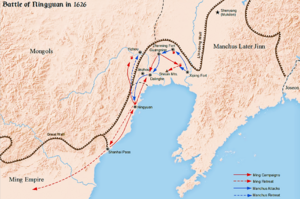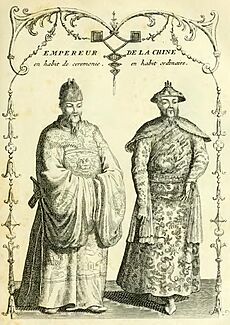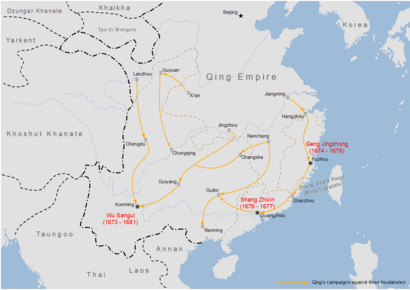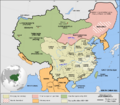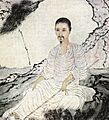Transition from Ming to Qing facts for kids
Quick facts for kids Ming-Qing transition |
||||||||||
|---|---|---|---|---|---|---|---|---|---|---|
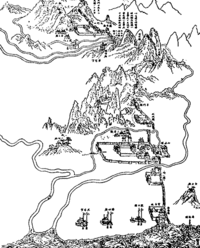 Battle of Shanhai Pass, one of the major battles during the Ming–Qing transition |
||||||||||
|
||||||||||
| Belligerents | ||||||||||
| Qing dynasty Manchus Ming defectors Southern and Eastern Mongols |
Southern Ming dynasty (1644–1662):
Combat support: Yehe Jurchens Tiandihui Chagatai Yarkent Khanate (1646–1650) Kumul Khanate Turpan Khanate Armament support: |
Shun dynasty (Li Zicheng) Xi dynasty (Zhang Xianzhong) Kingdom of Shu (She-An Rebellion) Evenk-Daur federation Nanai Hurka |
||||||||
| Commanders and leaders | ||||||||||
|
Supported by:
Zhu Hengjia, Prince of Jingjiang Zhu Yuyue, Prince of Tang (Shaowu Emperor) |
Sosoku |
||||||||
| Strength | ||||||||||
|
Manchu, Mongol, Han Bannermen Han Green Standard Army defectors (after 1644) By 1648, Han Bannermen made up 75% of the Eight Banners while Manchus at only 16%. |
Han Chinese soldiers, Hui Muslim soldiers, and Mongol cavalry |
Shun dynasty army varies between 60,000 and 100,000 men Zhang Xianzhong's army – 100,000 men 300,000 Yi fighters Nanai Hurka: 6,000 |
||||||||
| Casualties and losses | ||||||||||
| 25,000,000 deaths overall, including civilians | ||||||||||
The Ming-Qing transition was a long period of change in Chinese history. It happened between 1618 and 1683. During this time, the Ming dynasty fell, and the Qing dynasty rose to power. It was a big conflict involving the new Qing dynasty, the old Ming dynasty, and other smaller groups. In the end, the Qing dynasty took control of China.
Contents
How the Dynasties Changed
This period was a long conflict between several groups:
- The Qing dynasty, started by the Manchu Aisin Gioro family in what is now Northeast China.
- The Ming dynasty, the ruling family led by the Zhu clan.
- Other rebel groups in China, like the Xi dynasty led by Zhang Xianzhong and the Shun dynasty led by Li Zicheng.
In 1618, a Manchu leader named Nurhaci listed his complaints against the Ming. He had united the Jurchen tribes and started the Later Jin dynasty in 1616. This was like a declaration of war against the Ming. Nurhaci then rebelled against Ming rule in Liaoning.
At the same time, the Ming dynasty faced big money problems and peasant rebellions. In 1636, Nurhaci's successor, Hong Taiji, became emperor and renamed his dynasty the Qing. On April 24, 1644, the Ming capital, Beijing, fell to a rebel army led by Li Zicheng. The last Ming emperor, the Chongzhen Emperor, took his own life.
A Ming general named Wu Sangui then joined forces with the Qing. Together, they defeated Li Zicheng's rebels at the Battle of Shanhai Pass. On June 6, Qing and Wu Sangui's forces entered Beijing. The Ming dynasty fell due to many reasons, including natural disasters and peasant uprisings. However, it took almost 40 more years for the Qing to fully control all of China.
In 1661, the Kangxi Emperor became ruler. He fought against Ming loyalists and other rebellions, like the Revolt of the Three Feudatories led by Wu Sangui starting in 1673. In 1662, Zheng Chenggong (also known as Koxinga) created the Kingdom of Tungning in Taiwan. This was a state loyal to the Ming. But in 1683, the Qing defeated Tungning at the Battle of Penghu.
The Qing victory happened mostly because many Ming generals and soldiers joined their side. The Manchu army played a smaller role.
Manchus and the Late Ming Dynasty
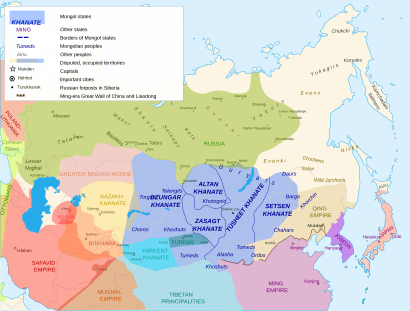
The Manchus were not nomads. They were farmers who lived in villages. They hunted and used bows and arrows while riding horses. Their main army was made of foot soldiers with bows, arrows, swords, and spears.
Manchus lived in walled cities and farmed like the Han Chinese before the Qing took over. Han Chinese soldiers on the border often mixed with Manchu tribes. Han Chinese soldiers who joined the Manchus sometimes even took Manchu names.
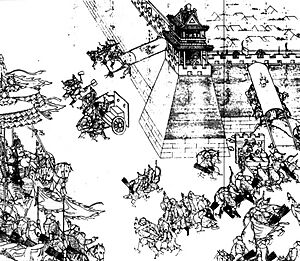
In the late Ming dynasty, army leaders stayed in command for a long time. This meant the central government lost control over regional armies. These army leaders became more loyal to local Jurchen chiefs than to the Ming government.
Rebellions by peasants also broke out in China in the 1640s. These included the sacking of Fengyang by Li Zicheng and Zhang Xianzhong.
Early Manchu Victories
Taking Over Liaodong and Other Tribes (1601–1626)
Nurhaci, a Jurchen chief, is seen as the founder of the Qing dynasty. The Ming dynasty first made him a local leader. But in 1616, he started the Later Jin dynasty. He united the Jurchen tribes, making them strong. His army included many Han Chinese who had joined him. In 1618, Nurhaci declared war on the Ming. He captured Fushun, a city near Shenyang.
By 1621, several Ming cities in Liaodong were taken by the Later Jin. This happened because some Ming commanders and soldiers betrayed the Ming and joined the Jurchens. For example, Ming general Li Yongfang surrendered Fushun and was given a Manchu princess to marry. In 1625, Nurhaci made Shenyang his new capital.
Nurhaci learned about Chinese military strategies from Chinese novels like Romance of the Three Kingdoms. In 1626, the Jurchens attacked Ningyuan but were defeated. Nurhaci was badly wounded and died soon after.
First Campaign Against Joseon (Korea)
After Nurhaci's death, the new khan, Hong Taiji, wanted a quick victory. In 1627, he sent 30,000 troops to invade Joseon (Korea). The Jurchens quickly defeated Joseon's border defenses. The Joseon king, King Injo, fled his capital, Seoul. Joseon was forced to make a peace treaty with the Jurchens.
Campaign Against Mongols (1625–1635)
The Khorchin Mongols joined Nurhaci in 1626 for protection. The Qing also fought the Chahar Mongols. In 1634, the Qing defeated the Mongol khan Ligdan Khan. This gave the Qing many horses and helped them claim to be the heirs of the Yuan dynasty.
Hong Taiji and the Qing Dynasty
Hong Taiji became the second ruler of the Later Jin in 1626. He started using Chinese ways of government and hired Han Chinese officials. He treated surrendered Ming commanders well, which helped build trust. He also started Confucian education, like the Ming.
In 1631, some Ming soldiers, led by Kong Youde and Geng Zhongming, rebelled against the Ming. They then joined the Jurchens. Hong Taiji was encouraged by his Han Chinese advisors to become Emperor of China. On May 14, 1636, he accepted. He changed the dynasty's name from Jin to Qing and became emperor in a Chinese-style ceremony.
Hong Taiji renamed the Jurchens to Manchus. This was to hide that the Jurchens had been subjects of the Han Chinese Ming dynasty. The Qing government also hid old records that showed their past loyalty to the Ming.
Marriages Between Han and Manchu People
Han Chinese generals who joined the Manchus were often given Manchu imperial women to marry. For example, Nurhaci married his granddaughter to the Ming general Li Yongfang in 1618. This policy continued after 1644. In 1648, the Shunzhi Emperor allowed Han Chinese men to marry Manchu women. This helped create harmony between the two groups.
Building a Mixed Military

When Ming generals like Li Yongfang and Kong Youde surrendered, they were allowed to keep their troops. The Qing needed these Han Chinese soldiers to defeat the Ming. Many Han Chinese soldiers joined the Qing's Eight Banners army. By 1648, Han Chinese soldiers made up 75% of the Eight Banners, while Manchus were only 16%. This mixed army was key to the Qing's success.
The Qing used Han Chinese soldiers for gunpowder weapons like muskets and cannons. Ming officers who joined the Qing kept their military ranks. Many Han Chinese officers became important military leaders for the Qing.
March to the Great Wall
Second Joseon Campaign (1636–1637)
Joseon (Korea) had to trade with the Later Jin and pay tribute. But Joseon still traded with the Ming. So, in 1636, Hong Taiji led Manchu, Mongol, and Han Chinese armies to invade Joseon again. Chinese soldiers helped a lot with artillery and naval forces. Joseon was forced to become a loyal subject of the Qing.
Campaigns Against Amur Tribes
The Qing defeated and absorbed tribes like the Evenks and Nanais in the Amur region. The Qing made all men in conquered areas shave the front of their heads and wear a queue (braid) like the Manchus.
Liaoxi Campaign (1638–1642)
Qing armies raided deep into China. The Ming emperor focused on fighting rebels instead of the Qing. In 1641, the Qing attacked Jinzhou. The city of Songshan also fell due to betrayal by a Ming commander. Ming general Wu Sangui tried to fight back but was defeated.
In 1642, the commander of Jinzhou, Zu Dashou, also joined the Qing. With these cities lost, the Ming's defenses in Liaoxi collapsed. This left Wu Sangui's forces at Shanhai Pass as the last barrier to Beijing.
Beijing and the North (1644)
In its last years, the Ming dynasty faced famines, floods, and economic problems. Rebellions broke out, led by figures like Li Zicheng and Zhang Xianzhong.
As the rebels got closer to Beijing, the Ming Chongzhen Emperor asked for urgent military help. On April 24, 1644, Li Zicheng's army broke into Beijing. The emperor took his own life. Li Zicheng then started his own Shun dynasty.
The Qing leaders saw this as a chance to take over China. They wanted to present themselves as avengers of the fallen Ming. Ming general Wu Sangui was marching to Beijing when he heard it had fallen. He returned to Shanhai Pass. Li Zicheng attacked Wu Sangui, but Wu's experienced troops defeated him.
Wu Sangui then asked the Qing for help to defeat the rebels and restore the Ming. But the Qing had no intention of restoring the Ming. They wanted to conquer China themselves. Wu Sangui had no choice but to join the Qing.
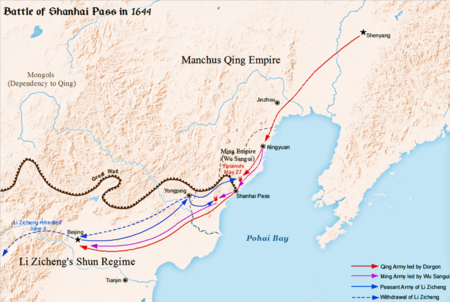
On May 27, Wu Sangui officially surrendered to the Qing. His troops fought Li Zicheng's army. Then, the Qing cavalry attacked, and Li Zicheng's forces were defeated. They fled back to Beijing. Li Zicheng looted Beijing for days before leaving the capital on June 4.
Who Was in Charge?

The Qing quickly took control of Beijing. They allowed many former Ming officials to join their government. Han Chinese Bannermen (Han Chinese soldiers in the Qing army) were very important in governing China. They filled most of the governor positions in the early Qing. This showed how much the Qing relied on Han Chinese.
The Qing also used the Green Standard Army, which was made of Han Chinese soldiers who had joined the Qing. These troops helped govern China daily. Manchu and Mongol Bannermen were only used in emergencies.
Fall of the South
Taking Over Jiangnan (1645)
After the Ming emperor died in Beijing, some Ming imperial family members tried to set up a new Ming government in Nanjing, the Ming's old capital. Zhu Yousong, the Prince of Fu, became emperor in June 1644. But his government was weak due to internal fights.
In April 1645, the Qing army attacked Jiangnan. They were helped by some Southern Ming commanders who surrendered. The Qing took key cities like Xuzhou. The Ming loyalist general Shi Kefa defended Yangzhou.
On May 13, 1645, Qing forces attacked Yangzhou. Most of the Qing army were Ming defectors. Shi Kefa's small force refused to surrender. On May 20, Qing cannons broke the city wall. The Qing ordered a brutal massacre of Yangzhou's people to scare other cities into surrendering.
On June 1, Qing armies crossed the Yangzi River and took Zhenjiang. A week later, they reached Nanjing. The Ming emperor had already fled. Nanjing surrendered without a fight on June 16, 1645. The Qing captured the fleeing emperor and took control of major cities like Suzhou and Hangzhou.
The Queue Order and Resistance (1645–1646)

On July 21, 1645, the Qing ruler Dorgon ordered all Chinese men to shave their foreheads and braid their hair into a queue, like the Manchus. Refusing meant death. This order was meant to show loyalty to the new dynasty. But for many Han Chinese, it was a great insult. It went against their traditions and made them feel like they were losing their identity.
This order caused many Chinese people to resist the Qing. In places like Jiading and Songjiang, the people fought back. But former Ming general Li Chengdong, now with the Qing, massacred the populations of these cities. Jiangyin also resisted for 83 days. When it fell, the Qing army massacred between 74,000 and 100,000 people. Many of these massacres were carried out by Han Chinese Bannermen.
Sichuan Campaign (1646–1658)
In 1646, the Qing sent armies to Sichuan to defeat Zhang Xianzhong's Xi dynasty. Zhang Xianzhong was killed in battle in February 1647. His generals continued fighting, but the Qing slowly took control of Sichuan by 1658.
Continued Fighting in the South
Conquest of the Southwest (1652–1661)
After Zhang Xianzhong's death, his generals retreated to Guizhou. They joined forces with the remaining Southern Ming loyalists. In August 1652, Li Dingguo, a former general of Zhang Xianzhong, recaptured Guilin from the Qing.
However, the Ming loyalists faced internal conflicts. In 1658, the Qing launched a large campaign to take Guizhou and Yunnan. The Ming emperor, Yongli Emperor, fled into Burma.
Flight to Burma (1659–1662)
In January 1659, the Qing took the capital of Yunnan. The Yongli Emperor fled to Burma. In 1662, the Yongli Emperor was captured by Wu Sangui in Burma and executed in Yunnan. This was the same Wu Sangui who had helped the Qing enter China in 1644.
Resistance from the Sea (1655–1663)
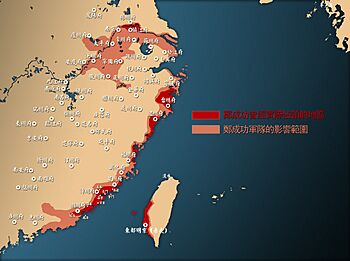
Zheng Chenggong (Koxinga), a loyalist to the Ming, continued to fight the Qing from the sea. He was adopted by the Longwu Emperor and given an imperial surname. In 1659, Koxinga sailed up the Yangtze River and threatened Nanjing. This caused great fear in Beijing, with some Manchus even thinking about returning to Manchuria.
However, Koxinga delayed his attack on Nanjing, giving the Qing time to prepare. His forces were defeated and retreated to Fujian. In April 1661, Koxinga fled to Taiwan. He defeated the Dutch there and set up the Kingdom of Tungning, a Ming loyalist state.
The Qing allied with the Dutch East India Company against Koxinga. But the alliance broke down because the Qing did not trust the Dutch.
The Three Feudatories (1674–1681)
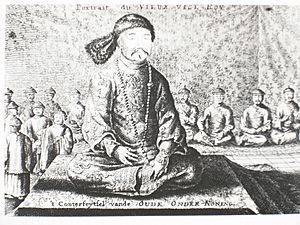
The Qing had given great power to three Han Chinese generals: Wu Sangui, Shang Kexi, and Geng Jimao. These "Three Feudatories" rebelled against the Kangxi Emperor in 1673. This was a very difficult time for the Qing.
However, the rebels were not united. Many Han Chinese commanders refused to join Wu Sangui, who had betrayed two dynasties. The Qing used a huge army of over 900,000 Han Chinese Green Standard Army soldiers to fight the rebellion. The rebellion was defeated by 1681.
Surrender of Taiwan (1683)

Koxinga died in 1662. His family continued to resist the Qing from Taiwan. But in 1683, the Kangxi Emperor sent Admiral Shi Lang with a large fleet to take Taiwan. Koxinga's grandson, Zheng Keshuang, surrendered Taiwan to the Qing after losing the Battle of Penghu. He and his soldiers were then made part of the Qing army.
The Qing sent most of the Ming princes living in Taiwan back to mainland China. The Prince of Ningjing and his five wives chose to die rather than be captured.
Aftermath and Impact
The Qing dynasty identified its state as "China," including lands like Manchuria, Xinjiang, Mongolia, and Tibet. They said that both Han and non-Han peoples were part of "China."
The transition from Ming to Qing was one of the most destructive wars in Chinese history. Many people died from fighting, famine, and disease. Some cities that resisted the Qing, like Yangzhou and Guangzhou, suffered massacres. However, cities that surrendered peacefully, like Beijing and Nanjing, were not harmed.
The period also saw widespread famine and disease. A massive drought in 1636 and a plague in 1643 killed many people. These disasters led to peasant rebellions. The population of China decreased greatly during this time.
After the Qing took over, some Han Chinese were moved into Manchu groups, changing their ethnic identity. Later, during the 1911 Xinhai revolution, some revolutionaries used stories of Qing massacres to encourage violence against Manchus.
Images for kids
-
A cannon cast in 1650 by the Southern Ming.
-
The Qing dynasty in 1820.
-
Shitao (1642–1707), a painter related to the Ming imperial family, who refused to serve the Qing.
-
Situation of Southern Ming.
-
The flight of the Yongli Emperor—the last sovereign of the Southern Ming dynasty—from 1647 to 1661.


